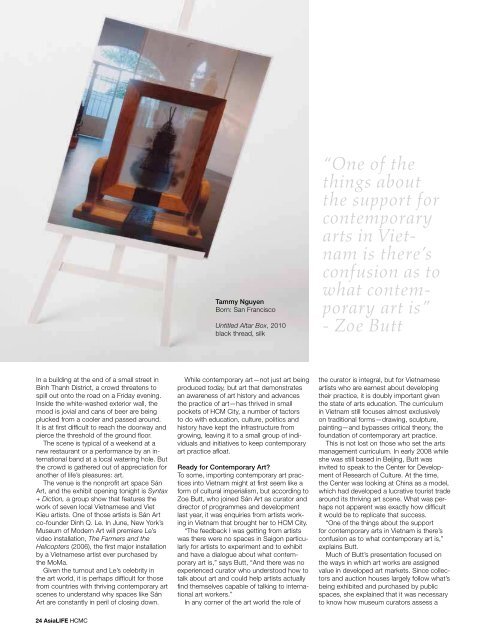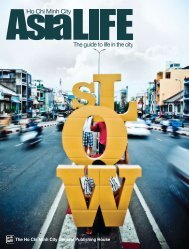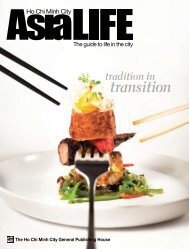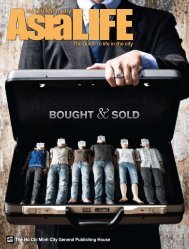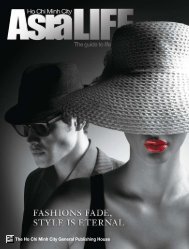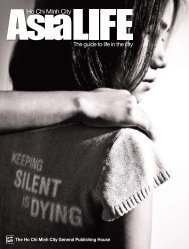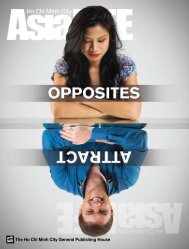Nam Ky Khoi Nghia - Asialife HCMC
Nam Ky Khoi Nghia - Asialife HCMC
Nam Ky Khoi Nghia - Asialife HCMC
Create successful ePaper yourself
Turn your PDF publications into a flip-book with our unique Google optimized e-Paper software.
In a building at the end of a small street in<br />
Binh Thanh District, a crowd threatens to<br />
spill out onto the road on a Friday evening.<br />
Inside the white-washed exterior wall, the<br />
mood is jovial and cans of beer are being<br />
plucked from a cooler and passed around.<br />
It is at first difficult to reach the doorway and<br />
pierce the threshold of the ground floor.<br />
The scene is typical of a weekend at a<br />
new restaurant or a performance by an international<br />
band at a local watering hole. But<br />
the crowd is gathered out of appreciation for<br />
another of life’s pleasures: art.<br />
The venue is the nonprofit art space Sán<br />
Art, and the exhibit opening tonight is Syntax<br />
+ Diction, a group show that features the<br />
work of seven local Vietnamese and Viet<br />
Kieu artists. One of those artists is Sán Art<br />
co-founder Dinh Q. Le. In June, New York’s<br />
Museum of Modern Art will premiere Le’s<br />
video installation, The Farmers and the<br />
Helicopters (2006), the first major installation<br />
by a Vietnamese artist ever purchased by<br />
the MoMa.<br />
Given the turnout and Le’s celebrity in<br />
the art world, it is perhaps difficult for those<br />
from countries with thriving contemporary art<br />
scenes to understand why spaces like Sán<br />
Art are constantly in peril of closing down.<br />
Tammy Nguyen<br />
Born: San Francisco<br />
Untitled Altar Box, 2010<br />
black thread, silk<br />
While contemporary art—not just art being<br />
produced today, but art that demonstrates<br />
an awareness of art history and advances<br />
the practice of art—has thrived in small<br />
pockets of HCM City, a number of factors<br />
to do with education, culture, politics and<br />
history have kept the infrastructure from<br />
growing, leaving it to a small group of individuals<br />
and initiatives to keep contemporary<br />
art practice afloat.<br />
Ready for Contemporary Art?<br />
To some, importing contemporary art practices<br />
into Vietnam might at first seem like a<br />
form of cultural imperialism, but according to<br />
Zoe Butt, who joined Sán Art as curator and<br />
director of programmes and development<br />
last year, it was enquiries from artists working<br />
in Vietnam that brought her to HCM City.<br />
“The feedback I was getting from artists<br />
was there were no spaces in Saigon particularly<br />
for artists to experiment and to exhibit<br />
and have a dialogue about what contemporary<br />
art is,” says Butt, “And there was no<br />
experienced curator who understood how to<br />
talk about art and could help artists actually<br />
find themselves capable of talking to international<br />
art workers.”<br />
In any corner of the art world the role of<br />
“One of the<br />
things about<br />
the support for<br />
contemporary<br />
arts in Vietnam<br />
is there’s<br />
confusion as to<br />
what contemporary<br />
art is”<br />
- Zoe Butt<br />
the curator is integral, but for Vietnamese<br />
artists who are earnest about developing<br />
their practice, it is doubly important given<br />
the state of arts education. The curriculum<br />
in Vietnam still focuses almost exclusively<br />
on traditional forms—drawing, sculpture,<br />
painting—and bypasses critical theory, the<br />
foundation of contemporary art practice.<br />
This is not lost on those who set the arts<br />
management curriculum. In early 2008 while<br />
she was still based in Beijing, Butt was<br />
invited to speak to the Center for Development<br />
of Research of Culture. At the time,<br />
the Center was looking at China as a model,<br />
which had developed a lucrative tourist trade<br />
around its thriving art scene. What was perhaps<br />
not apparent was exactly how difficult<br />
it would be to replicate that success.<br />
“One of the things about the support<br />
for contemporary arts in Vietnam is there’s<br />
confusion as to what contemporary art is,”<br />
explains Butt.<br />
Much of Butt’s presentation focused on<br />
the ways in which art works are assigned<br />
value in developed art markets. Since collectors<br />
and auction houses largely follow what’s<br />
being exhibited and purchased by public<br />
spaces, she explained that it was necessary<br />
to know how museum curators assess a<br />
work of art, and what they’re often assessing<br />
is how the artist interprets the society in<br />
which he or she is working.<br />
This view of art’s relevance is, at least on<br />
the surface, at odds with the opinion of the<br />
Ministry of Culture, the body responsible<br />
for granting permission to exhibitions. As<br />
recently as last year, the ministry reasserted<br />
that its priorities are “to raise the cultural and<br />
spiritual life of the people, promote traditional<br />
and cultural values and teach the tradition of<br />
patriotism to build a better country.”<br />
The state is not the only sector that finds<br />
this concept of art problematic. Having<br />
been founded by four Viet Kieu artists, Sán<br />
Art sometimes suffers from the perception<br />
among local Vietnamese that it is just for Viet<br />
Kieu. While Butt says reaching out to Vietnamese<br />
who may not have the opportunity<br />
to travel is a concern, she acknowledges<br />
that many are intimidated by more conceptual<br />
forms of art for which they seldom<br />
have any reference point. More worrisome,<br />
though, is the perception held by some local<br />
Vietnamese artists.<br />
In at least one case, an artist expressed to<br />
Butt that he believes work that does not depict<br />
subjects familiar to Vietnamese people<br />
is not Vietnamese, an opinion that is out<br />
of sync with the zeitgeist of an increasingly<br />
transnational art world and a market that<br />
takes into consideration an artist’s foreign<br />
residencies and international exhibits when<br />
pricing art.<br />
Whatever the root of opinions such as<br />
this, they threaten to fracture HCM City’s<br />
art scene and undermine the support that<br />
young artists who are embracing more contemporary<br />
practice might otherwise receive<br />
from their peers.<br />
Market Pressure<br />
Since the market liberalization of doi moi<br />
in 1986, what constitutes Vietnamese art<br />
has also been complicated by the influence<br />
of commerce. As Professor Nora A. Taylor<br />
explains in her seminal book, Painters in<br />
Hanoi: An Ethnography of Vietnamese Art,<br />
the shift from state patronage of the arts to<br />
a free market model, as well as the influx of<br />
Western tourists led to an art boom in the<br />
mid-90s that would have far-reaching effects<br />
on contemporary art production.<br />
“In the decade between 1990 and 2000,”<br />
Taylor writes, “art became such a lucrative<br />
source of income that, understandably,<br />
everyone wants their share of the profits<br />
… This has meant that artists have gone<br />
from being reclusive, potentially politically<br />
sensitive, educated but economically poor<br />
individuals to wealthy, socially desirable<br />
personae.”<br />
This transformation, explains Taylor,<br />
contributed to a situation in which commercial<br />
interests began to compromise artistic<br />
integrity. Since Westerners were often more<br />
Tiffany Chung<br />
Born: Danang<br />
Co-founder of San Art<br />
Sugarcane Kumquat Mixed<br />
Juice, 2007<br />
Polyethylene foam, pompoms,<br />
MDF, wood, wire, thermoplastic<br />
adhesive<br />
below: Enokiberry Creators in<br />
the lab, 2008<br />
Digital c-print<br />
150 x 100 cm<br />
24 asialife <strong>HCMC</strong> asialife <strong>HCMC</strong> 25


